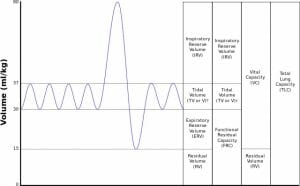Vital Capacity Definition
Vital capacity is the amount of air that the lungs can expel after having been filled completely. The vital capacity represents the change in volume from completely emptied lungs to completely filled lungs. In human medicine, vital capacity is an important measure of a person’s respiratory health. A healthy adult will have a vital capacity between 2 and 5 liters.
A severely decreased vital capacity is an indication of restrictive lung disease, in which the lungs cannot expand fully. If the vital capacity is normal, but the lungs are still not functioning properly, it could be an indication of obstructive lung disease, in which the lungs are clogged or blocked in the airways.
The vital capacity can be measured with the use of a spirometer, which can also separate the different components of the vital capacity. As seen in the following spirograph, the vital capacity consists of the expiratory reserve volume, the tidal volume, and the inspiratory reserve volume. The expiratory and inspiratory reserve volumes are the volumes of air taken in and exhaled above and beyond normal breaths, while the tidal volume represents the standard, low-volume breath.
Vital Capacity Formula
There are two formulae for vital capacity, based on the sex of the subject. In both of the following formula, H represents height in centimeters, while A represents the age of a person in years.
Female:
Vital Capacity = (21.78 – 0.101a) x h
Male:
Vital Capacity = (27.63 – 0.112a) x h
Vital capacity is typically measured in cubic centimeters, a measure of volume. These formulas simply show the average vital capacity for a man or woman of a specific age and sex.
For instance, a 35-year-old woman who is 160 cm should have the following vital capacity:
Vital Capacity = (21.78 – 0.101(35)) x 160
Vital Capacity = 2,919.2
If a female blows into a spirometer and only has a vital capacity of 2,000 cm3 it would be an indication that there was something wrong with her lungs, as they are not able to expand all the way open. Many different diseases, conditions, and genetic conditions can cause a decreased vital capacity.
Related Biology Terms
- Tidal Volume – The volume of air breathed in an out during normal breaths.
- Expiratory Reserve Volume – The extra volume of air that can be pushed out of the lungs when forced.
- Inspiratory Reserve Volume – An extra amount of air that can be inhaled, increasing the lung capacity.
- Residual Volume – An amount of air that cannot be expelled from the lungs, which keeps them from collapsing.
Quiz
1. What is the target vital capacity of a 42-year-old male who is 190 cm tall?
A. 3290
B. 4000
C. 4356
2. What happens to the vital capacity of a 4-year-old with a hotdog stuck in his throat?
A. It decreases
B. It increases
C. It stays the same

